Authentication of a Painting Attributed to the Rembrandt School
Abstract
1. Introduction
- −
- modification of an original in the style of an earlier or later period and the addition of artistic elements of refinement (more expensive framing or casing, ornamentation, fastening and display elements, etc.);
- −
- structural and polychrome changes following preservation and restoration;
- −
- unjustified or insufficiently documented retouching, by depainting and repainting.
- −
- falsification or plagiarism by making reproductions or copies without the consent of the author, owner, or custodian;
- −
- counterfeiting by signing, deleting, adding/completing etc.;
- −
- illegal transhumance or trafficking;
- −
- theft and substitution from collections;
- −
- destruction/vandalism;
- −
- changing contexts related to situations that allow for good value;
- −
- destroying the traces of the crime; and others.
- −
- signing old works by unknown or unattributed authors with the names of famous artists;
- −
- aging new copies (by patination and cracking) and countersigning them;
- −
- failure to comply with the regime of protection of works of art of cultural heritage;
- −
- substitution or theft from collections;
- −
- false authentications, dating, and attributions by experts or qualified/authorized institutions;
- −
- knowingly facilitating the purchase of counterfeit goods;
- −
- favoring traffickers and counterfeiters through concealment, support, logistical support, etc.;
- −
- inappropriate, often aggressive, preservation and restoration interventions to highlight details, obliterate traces or remove archaeometric or artifactometric features;
- −
- hiding, destroying, or vandalizing works of art that have the status of cultural or historical assets.
- −
- counterfeits produced for commercialization (from bargains to masterpieces carefully crafted following the original);
- −
- reproductions or copies produced by the author for sentimental reasons (reference works);
- −
- reproductions or copies produced by pupils for didactic, sentimental/admiring reasons and to gain artistic notoriety (reference artifacts or standards for school, mentorship, etc.);
- −
- forgeries produced to practice artistic skills and abilities (artistic styles and techniques representative of an era, school or geographical area);
- −
- −
- −
- −
- forgeries produced with the intention of replacing the originals for the purpose of removal, i.e., for replacement from collections, storage, or museums.
1.1. The Role in the Authentication of Flemish Paintings of Crackle Models and the Characteristics of the Textile Support
1.2. Comparative Study of Rembrandt-Type Portrait Paintings with Lace Collar
2. The Experimental Part
2.1. Painting Anamnesis
2.2. Experimental Protocol and Image Processing Algorithms, Sampling, and Processing of Material Samples
2.3. Aesthetic–Artistic Analysis
2.4. Conservation Status
2.5. Microscopic Analysis Methods and Techniques
2.6. Optical Microphotography
2.7. SEM-EDX Analysis
2.8. ATR—FTIR Spectrometry
3. Archaeometric and Chemometric Dating Characteristics
- −
- the way and degree of elaboration of colours in painting, when gradually (sequentially) analysing the classical system of support—preparation—drawing—colour—varnish;
- −
- summative systems of the polychrome layer (pigment + binder + varnish + anchored dirt) and of the preparation (filler and binder) with their stratigraphic arrangement, corresponding to the thin layer technique, using a small, wide brush made of pig hair and a thin-tipped one in the form of a quill made of squirrel or cat hair (the latter for the anatomical details of the face and the lacy collar);
- −
- evaluation of chemical congruences in summative systems, by involving errors in the EDX atomic composition determination, a very important tool in expert determination;
- −
- the layout and penetration of the anchored dirt areas with reference to the protective lacquer and oil colour pigments, respectively (depth ranging between 100 and 150 μm);
- −
- the arrangement and degree of stratigraphic penetration of the craquelure networks and lacunar areas, the latter resulting from loss of material during the roofing of the colour layer and preparation (craquelure networks typical of medieval paintings in The Netherlands, with depths ranging between 500 and 800 μm);
- −
- the range of variation of the thickness of the craquelure and the extension of the lines of force (craquelure aperture varying between 500 and 800 μm, craquelure depth varying between 300 and 450 μm, the length of the side of a craquelure on a force vector in the network (network mosaic side) varying from 1000 to 2500 μm);
- −
- depth of penetration of archaeometric characteristics (the degree of penetration of porosity in the volume phase of the materials analysed, varying between 1.0 and 2.5 μm);
- −
- the morphology of the pictorial surfaces, emphasizing iridescence/alveolars, texture and microtopography;
- −
- shape and arrangement of the pigment granules and preparation, respectively their particle size evaluation (between 10 and 30 μm).
4. Conclusions
Author Contributions
Funding
Institutional Review Board Statement
Informed Consent Statement
Data Availability Statement
Conflicts of Interest
References
- Sandu, I.; Cotiuga, V. Cercetarea Bunurilor de Patrimoniu şi a Documentelor Falsificate; Editura AIT Laboratory: Bucuresti, Romania, 2011; ISBN 978-606-8363-09-7. [Google Scholar]
- Sandu, I.; Vasilache, V. Conservarea Amprentelor Formă şi a Urmelor Materiale; Editura AIT Laboratory: Bucuresti, Romania, 2011; ISBN 978-606-8363-09. [Google Scholar]
- Matei, G. Investigarea Criminalistică a Infracţiunilor Privind Operele de Artă şi Artefactele Arheologice; Editura Univers Juridic: Bucureşti, Romania, 2019. [Google Scholar]
- Baker, P. Protecting Art, Protecting Artists and Protecting Consumers Conference; Autralian Institute of Criminology: Sydney, Australia, 1999. [Google Scholar]
- Arnau, F. Arta Falsificatorilor–Falsificatorii Artei; Editura Meridiane: Bucureşti, Romania, 1970. [Google Scholar]
- Meacham, W. The Authentication of the Turin Shroud-An Issue in Archaeological Epistemology. Curr. Antropol. 1983, 24, 291–293. [Google Scholar] [CrossRef]
- Craig, E.A.; Bresse, R.R. Image Formation and the Shroud of Turin. J. Imaging Sci. Technol. 1994, 38, 59–67. [Google Scholar]
- Bowman, S.G.E.; Amber, J.C.; Lesse, M.N. Re-evaluation of British Museum radiocarbon dates issued between 1980 and 1984. Radiocarbon 1990, 32, 59–79. [Google Scholar] [CrossRef][Green Version]
- Kilmon, J. The Shroud of Turin. Genuine artifact or manufactured relic? J. Archaeol. Inst. Am. 1997, 1, 13. [Google Scholar]
- Nickell, J. Inquest Day for the Shroudv of Turin; Prometheus Books: Buffalo, NY, USA, 1999. [Google Scholar]
- Benford, M.S.; Marino, J.G. Textile Evidence Supports Skewed Radiocarbon Date of Shroud of Turin; Worldwide Congress Sindone 2000: Orvieto, Italy, 2002. [Google Scholar]
- Gregory, W.K. The Dawn Man of Piltdown. Am. Mus. J. Am. Mus. Nat. Hist. 1914, 14, 189–200. [Google Scholar]
- Tanasa, P.O.; Sandu, I.; Vasilache, V.; Sandu, I.G.; Negru, I.C.; Sandu, A.V. Authentication of a Painting by Nicolae Grigorescu Using Modern Multi-Analytical Methods. Appl. Sci. Basel 2020, 10, 3558. [Google Scholar] [CrossRef]
- Sandu, I.; Tanasa, O.; Negru, I.C.; Lupascu, M.M.; Vasilache, V.; Chirila, M. Authentication of a Painting by Rene Magritte. Int. J. Conserv. Sci. 2022, 13, 1445–1462. [Google Scholar]
- La Nasa, J.; Doherty, B.; Rosi, F.; Braccini, C.; Broers, F.T.H.; Degano, I.; Matinero, J.M.; Miliani, C.; Modugno, F.; Sabatini, F.; et al. An integrated analytical study of crayons from the original art materials collection of the MUNCH museum in Oslo. Sci. Rep. 2021, 11, 7152. [Google Scholar] [CrossRef]
- Macchia, A.; Aureli, H.; Colasanti, I.A.; Rivaroli, L.; Tarquini, O.; Sabatini, M.; Dattanasio, M.; Pantoja Munoz, L.; Colapietro, M.; La Russa, M.F. In Situ Diagnostic Analysis of The Second Half of XVIII Century “Morte Di Sant’orsola” Panel Painting Coming from Chiesa Dei Santi Leonardo E Erasmo Roccagorga (Lt, Italy). Int. J. Conserv. Sci. 2012, 12, 1377–1390. [Google Scholar]
- Dupuis, G.; Menu, M. Quantitative characterisation of pigment mixtures used in art by fibre-optics diffuse-reflectance spectroscopy. Appl. Phys. A Mater. Sci. Process. 2006, 83, 469–474. [Google Scholar] [CrossRef]
- Lorusso, S.; Vandini, M.; Matteucci, C.; Tumidei, S.; Campanella, L. Anamnesistorica ed indaginediagnostica del dipinto ad olio su tavola “Madonna con bambino e santi Girolamo e Caterina da Siena” attribuibile a Domenico Beccafumi (1486–1551). Quad. Sci. 2003, 47–68. Available online: https://www.researchgate.net/publication/266796133 (accessed on 10 May 2024).
- Sandu, I.C.A.; Bracci, S.; Sandu, I. Instrumental analyses used in the authentification of old paintings-I. Comparison between two icons of XIXth century. Rev. Chim. 2006, 57, 796–802. [Google Scholar]
- Sandu, I.C.A.; Vasilache, V.; Sandu, I.; Luca, C.; Hayashi, M. Authentication of the Ancient Easel-paintings through Materials Identification from the Polychrome Layers III. Cross-section Analysis and Staining Test. Rev. Chim. 2008, 59, 855–866. [Google Scholar] [CrossRef]
- Sandu, I.C.A.; Bracci, S.; Sandu, I.; Lobefaro, M. Integrated Analytical Study for the Authentication of Five Russian Icons (XVI-XVII centuries). Microsc. Res. Tech. 2009, 72, 755–765. [Google Scholar] [CrossRef] [PubMed]
- Cristache, R.A.; Sandu, I.C.A.; Simionescu, A.E.; Vasilache, V.; Budu, A.M.; Sandu, I. Multianalytical Study of the Paint Layers Used in Authentication of Icon from XIXth Century. Rev. Chim. 2015, 66, 1034–1037. [Google Scholar]
- Cristache, R.A.; Sandu, I.C.A.; Budu, A.M.; Vasilache, V.; Sandu, I. Multi-analytical Study of an Ancient Icon on Wooden Panel. Rev. Chim. 2015, 66, 348–352. [Google Scholar]
- Slotsgaard, T.L.; Pastorelli, G.; Buti, D.; Scharff, M.; Andersen, C.K. Crack morphology and its correlation with ground materials used in paintings by Danish portrait painter Jens Juel. J. Cult. Herit. 2024, 69, 47–56. [Google Scholar] [CrossRef]
- Giorgiutti-Dauphiné, F.; Pauchard, L. Painting cracks: A way to investigate the pictorial matter. J. Appl. Phys. 2016, 120, 065107. [Google Scholar] [CrossRef]
- Andrews, I. Dutch and Flemish Old Master Paintings. Apollo-Int. Mag. Collect. 2007, 166, 104–105. [Google Scholar]
- Roberts, K. Dutch and Flemish Old Master Paintings and Drawings. Burlingt. Mag. 1976, 118, 664. [Google Scholar]
- Cornelis, B.; Museum of Fine Arts Budapest Old Masters’ Gallery. Summary catalogue, vol 2, Early Netherlandish, Dutch and Flemish paintings. Burlingt. Mag. 2001, 143, 772. [Google Scholar]
- Da Rugna, J.; Chareyron, G.; Pillay, R.; Joly, M. A framework for analysis of large database of old art paintings. Comput. Vis. Image Anal. Art II 2011, 7869, 786907. [Google Scholar] [CrossRef]
- Issa, A.A.A.K.B.; Mohie, M.A. The Conservation of an Oil Painting by Antonio Schranz, 1841 AD. Int. J. Conserv. Sci. 2021, 12, 417–428. [Google Scholar]
- Bucklow, S. The description of craquelure patterns. Stud. Conserv. 1997, 42, 129–140. [Google Scholar] [CrossRef]
- Bucklow, S. The description and classification of craquelure. Stud. Conserv. 1999, 44, 233–244. [Google Scholar] [CrossRef]
- Bucklow, S. Consensus in the classification of craquelure. Hamilt. Kerr Inst. Bull. 2000, 3, 61–73. [Google Scholar]
- Bucklow, S. The classification of craquelure patterns. In Conservation of Easel Paintings, 2nd ed.; Routledge: London, UK, 2020. [Google Scholar]
- Pauchard, L.; Giorgiutti-Dauphiné, F. Craquelures and pictorial matter. J. Cult. Herit. 2020, 46, 361–373. [Google Scholar] [CrossRef]
- Toussaint, A. Influence of pigmentation on the mechanical properties of paint films. Prog. Org. Coat. 1974, 2, 237–267. [Google Scholar] [CrossRef]
- Zosel, A. Mechanical behaviour of coating films. Prog. Org. Coat. 1980, 8, 47–79. [Google Scholar] [CrossRef]
- Mayer, R.; Smith, E. The Artist’s Handbook of Materials and Techniques, 3rd ed.; Mayer, R., Ed.; Revised and Expanded, Faber: London, UK, 1973. [Google Scholar]
- Karpowicz, A. A study on development of cracks on paintings. J. Am. Inst. Conserv. 1990, 29, 169–180. [Google Scholar] [CrossRef]
- Bratasz, Ł.; Vaziri Sereshk, M.R. Crack Saturation as a Mechanism of Acclimatization of Panel Paintings to Unstable Environments. Stud. Conserv. 2018, 63 (Suppl. 1), 22–27. [Google Scholar] [CrossRef]
- Bratasz, Ł.; Akoglu, K.G.; Kékicheff, P. Fracture saturation in paintings makes them less vulnerable to environmental variations in museums. Herit. Sci. 2020, 8, 11. [Google Scholar] [CrossRef]
- Available online: https://ro.wikipedia.org/wiki/Rembrandt (accessed on 1 January 2024).
- Silva, D. The Rembrandt Affair; The Library of Congress Catalog Record, G.P. Putnam’s Sons: New York, NY, USA, 2010; ISBN 9780399156588. [Google Scholar]
- Strauss, W.L.; van der Meulen, M. The Rembrandt Documents; New York, 1979, 150, Doc. 1638/2. Cf. S. A. C. Dudok van Heel, Peter Schatborn, Eva Ornstein-van Slooten, Dossier Rembrandt/The Rembrandt Papers (Exh. cat. Amsterdam, Museum Het Rembrandthuis) (Amsterdam, 1987). 72–73.
- Web Gallery of Art. Available online: http://www.wga.hu/index1.html (accessed on 1 January 2024).
- Available online: https://www.parool.nl/kunst-media/het-is-bijna-niet-voor-te-stellen-maar-in-vorige-eeuwen-vond-men-rembrandt-een-boerenkinkel-en-de-nachtwacht-een-mislukt-schilderij~bf2049df/?referrer=https://ro.wikipedia.org/ (accessed on 1 January 2024).
- Available online: https://portal.dnb.de/opac.htm?method=simpleSearch&cqlMode=true&query=nid%3D11859964X (accessed on 1 January 2024).
- Available online: https://www.rembrandt-van-rijn.com/quotes/ (accessed on 1 January 2024).
- Available online: https://www.britanica.com/biography/Rembrandt-van-rijn (accessed on 1 January 2024).
- Available online: https://www.rembrandtresearchproject.org/ (accessed on 14 February 2024).
- A Corpus of Rembrandt Paintings VI, Rembrandt’s Paintings Revisited—A Complete Survey; Springer: Dordrecht, The Netherlands, 2015; p. 748. ISBN 978-94-017-9173-1. (Hardcover).
- Sandu, I.C.A.; Luca, C.; Sandu, I.; Vasilache, V.; Hayashi, M. Authentication of the ancient easel paintings through materials identification from the polychrome layers-II. Analysis by means of the FT-IR spectrophotometry. Rev. De Chim. 2008, 59, 384–387. [Google Scholar] [CrossRef]

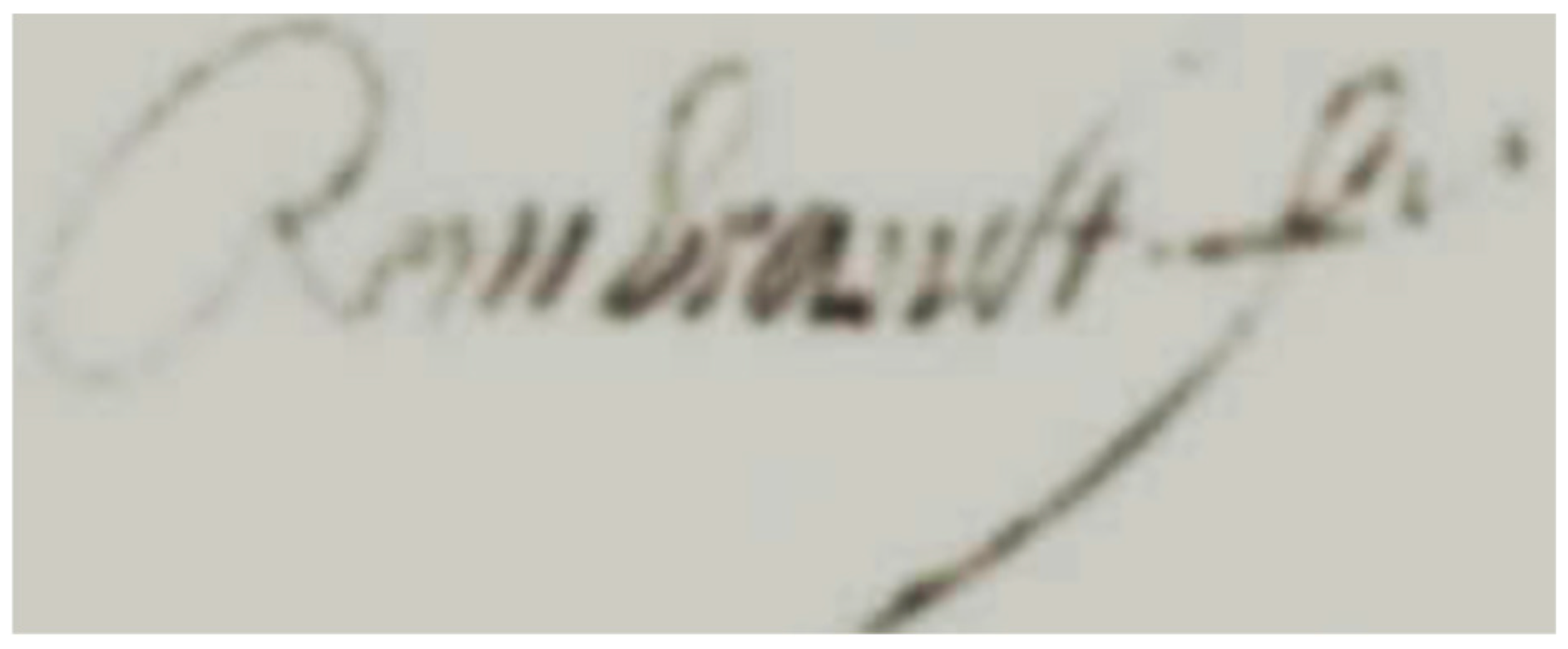




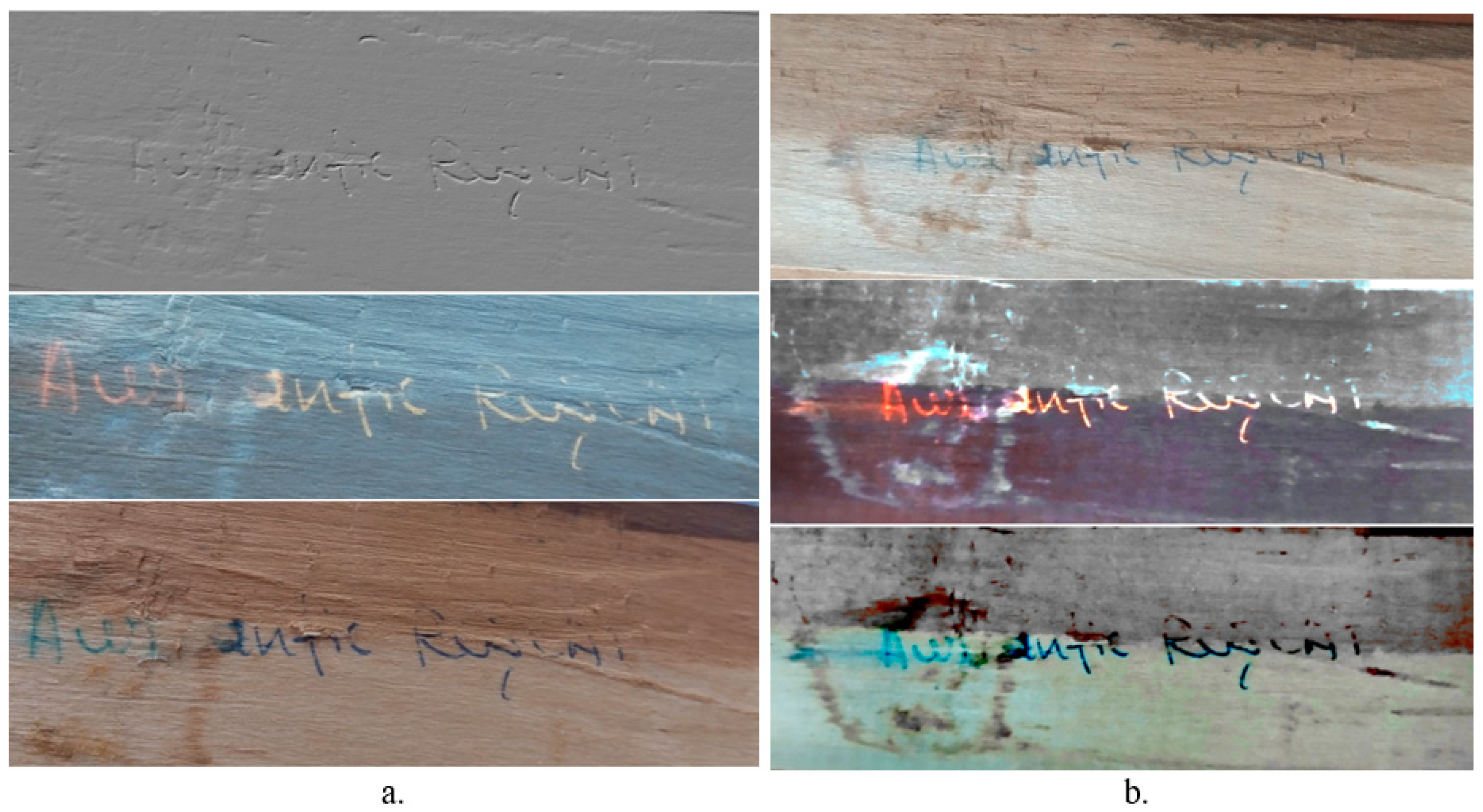


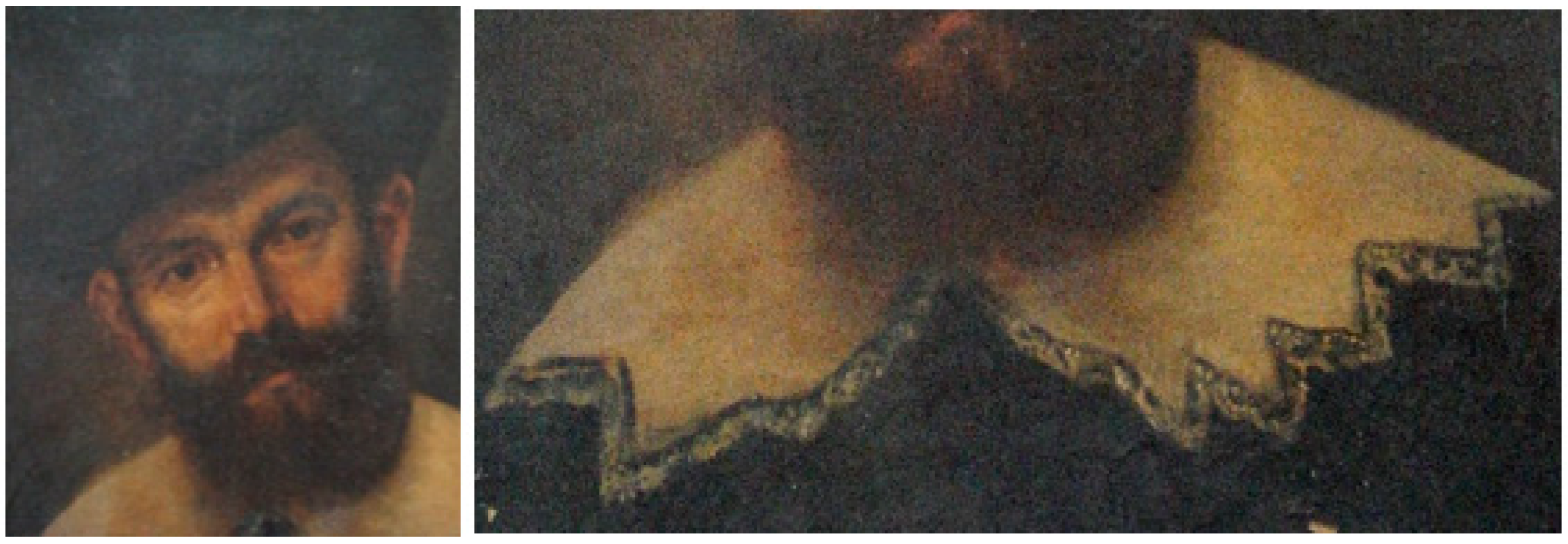


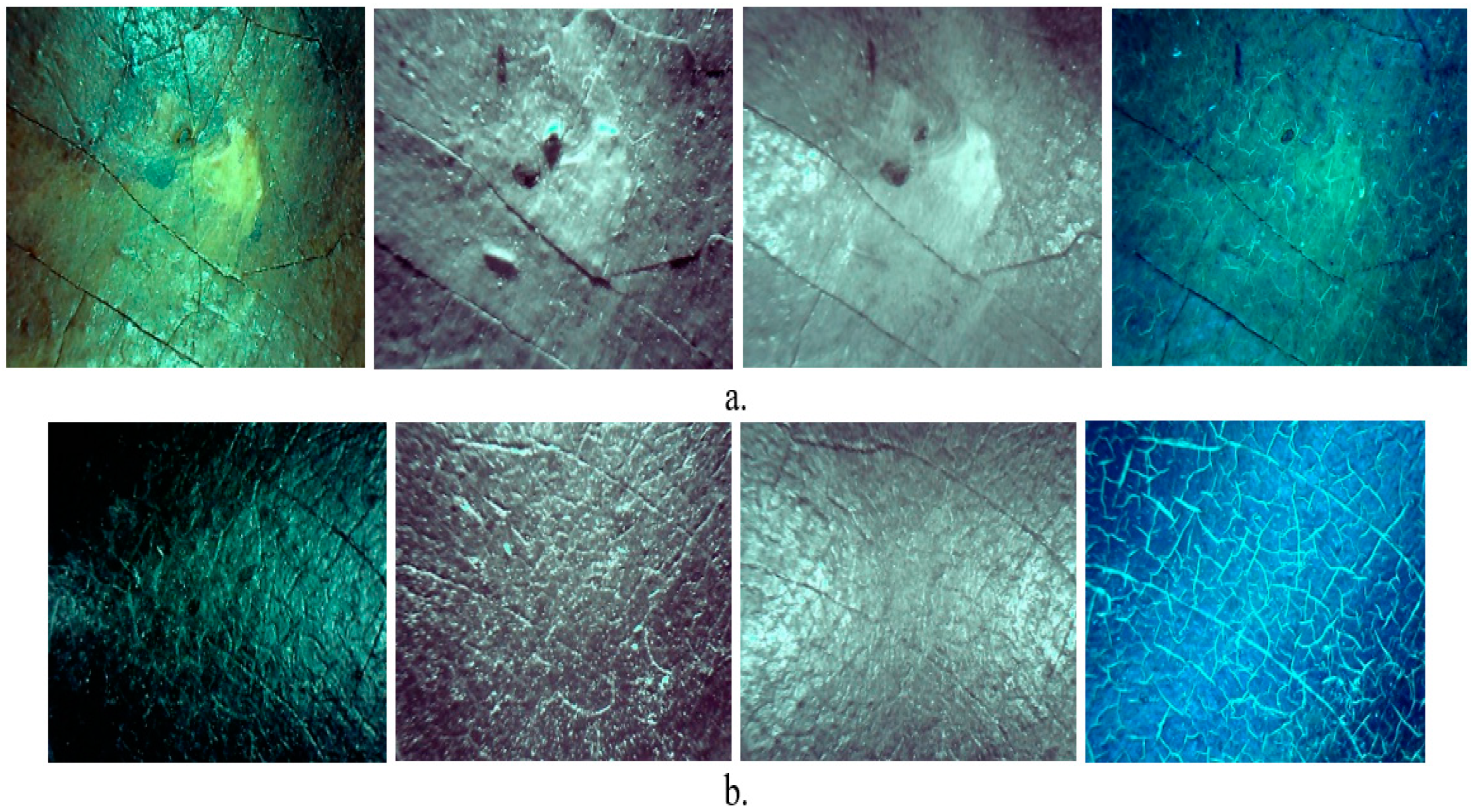
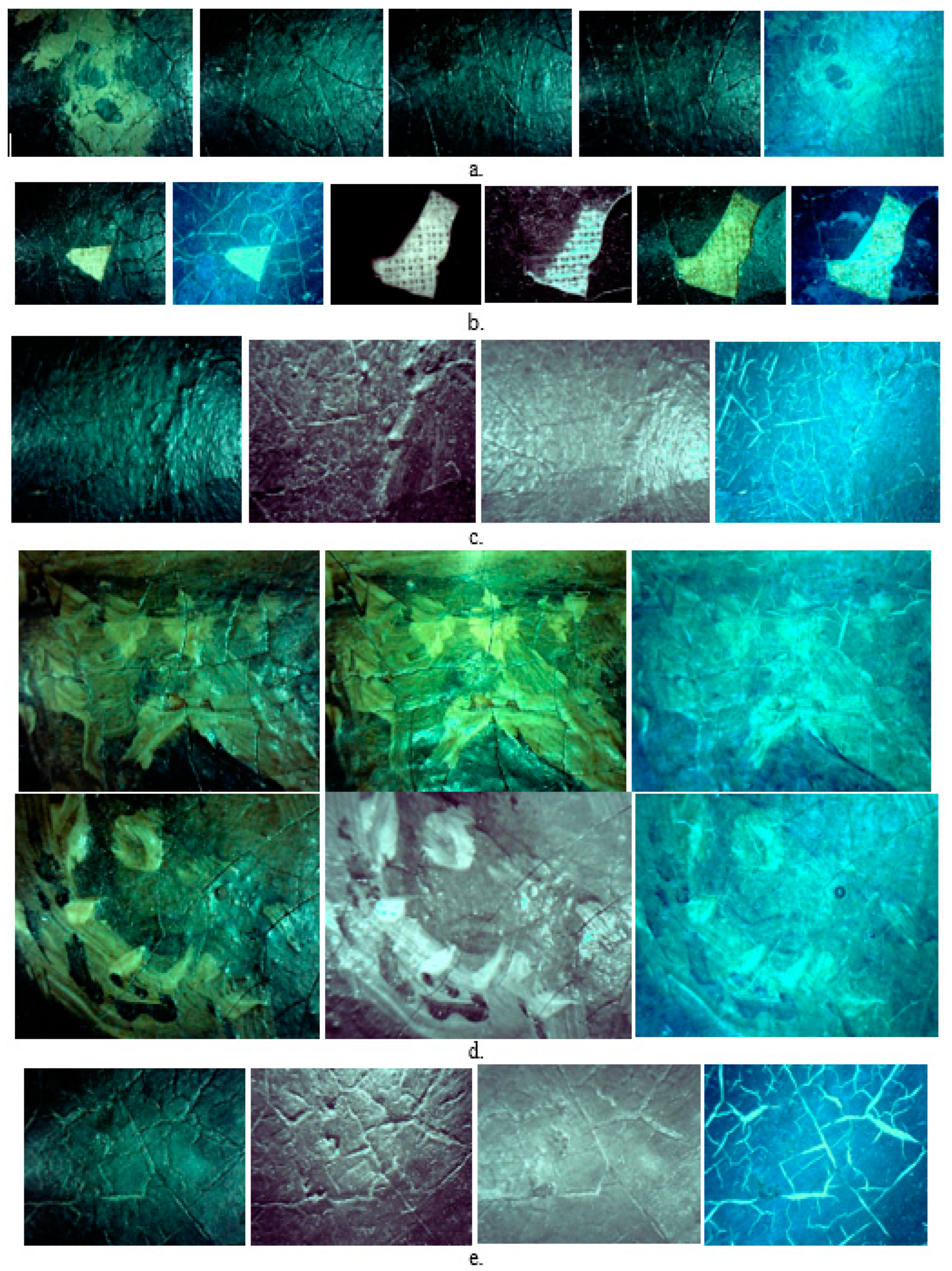

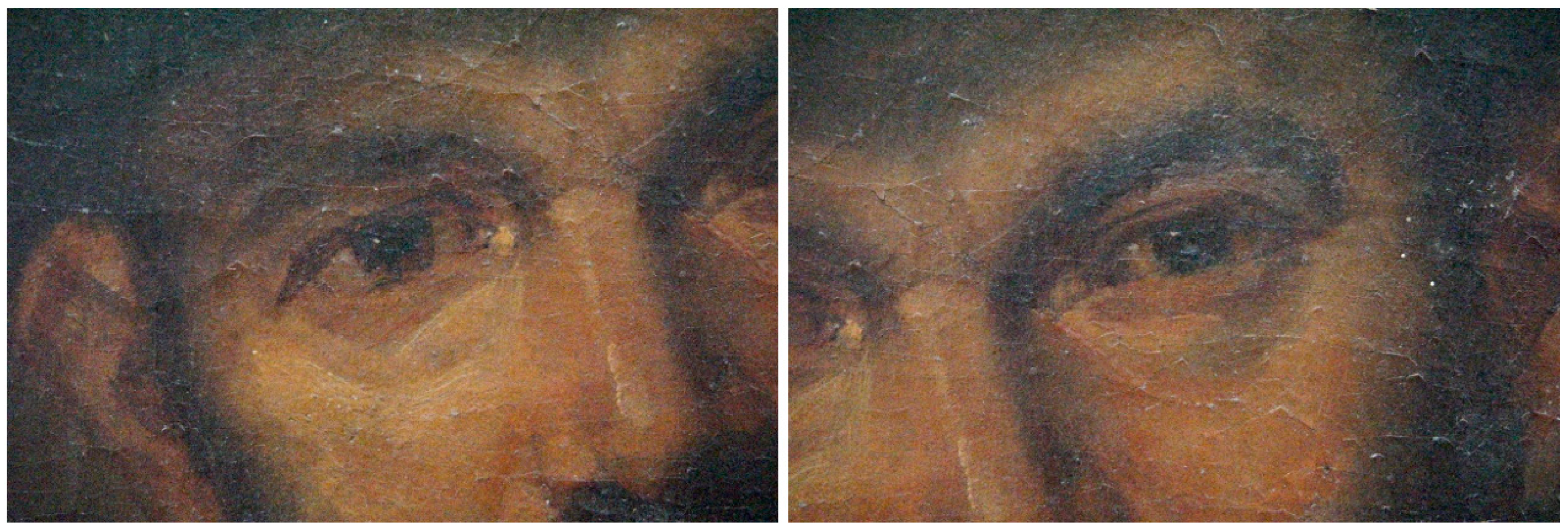

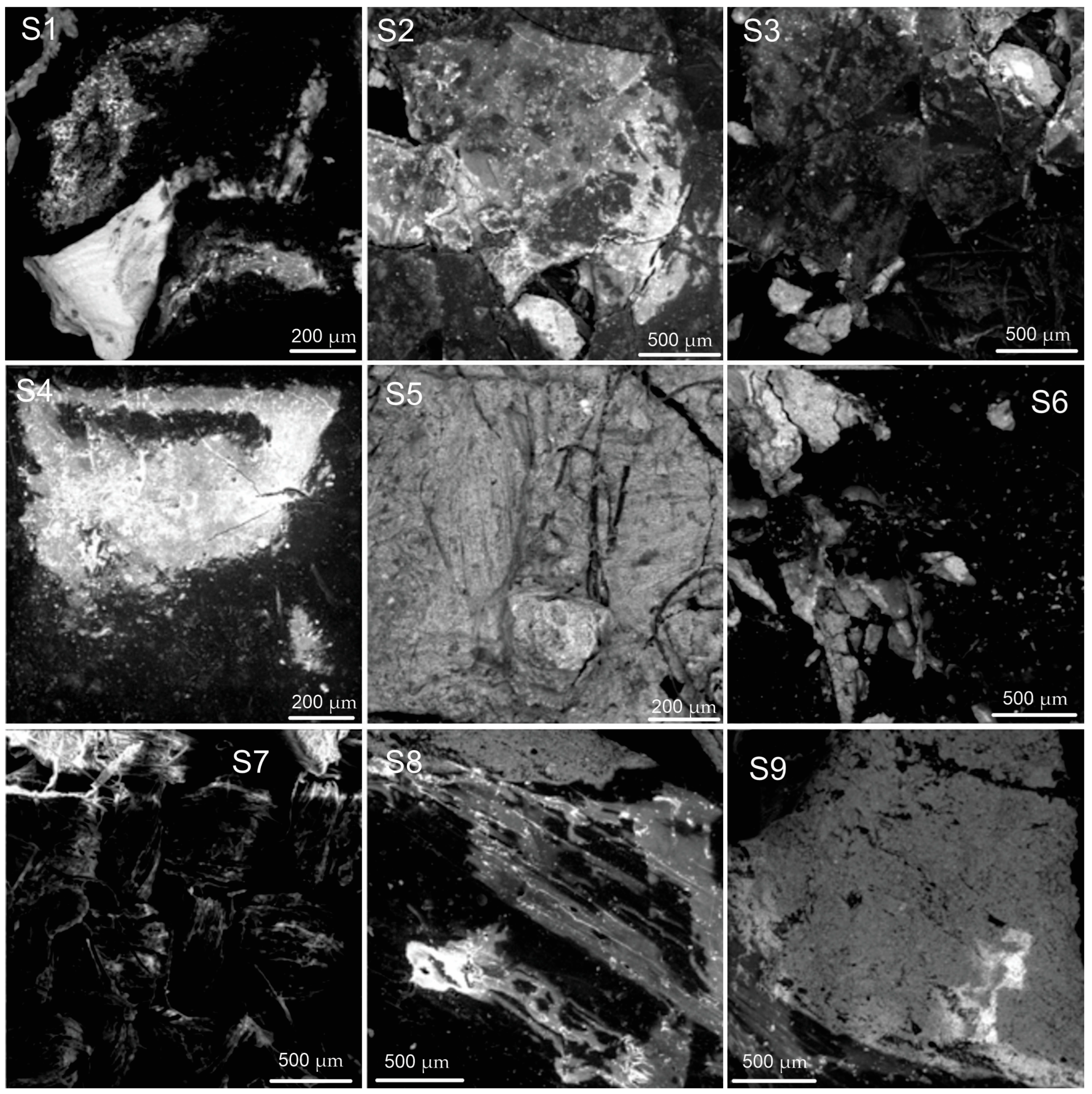
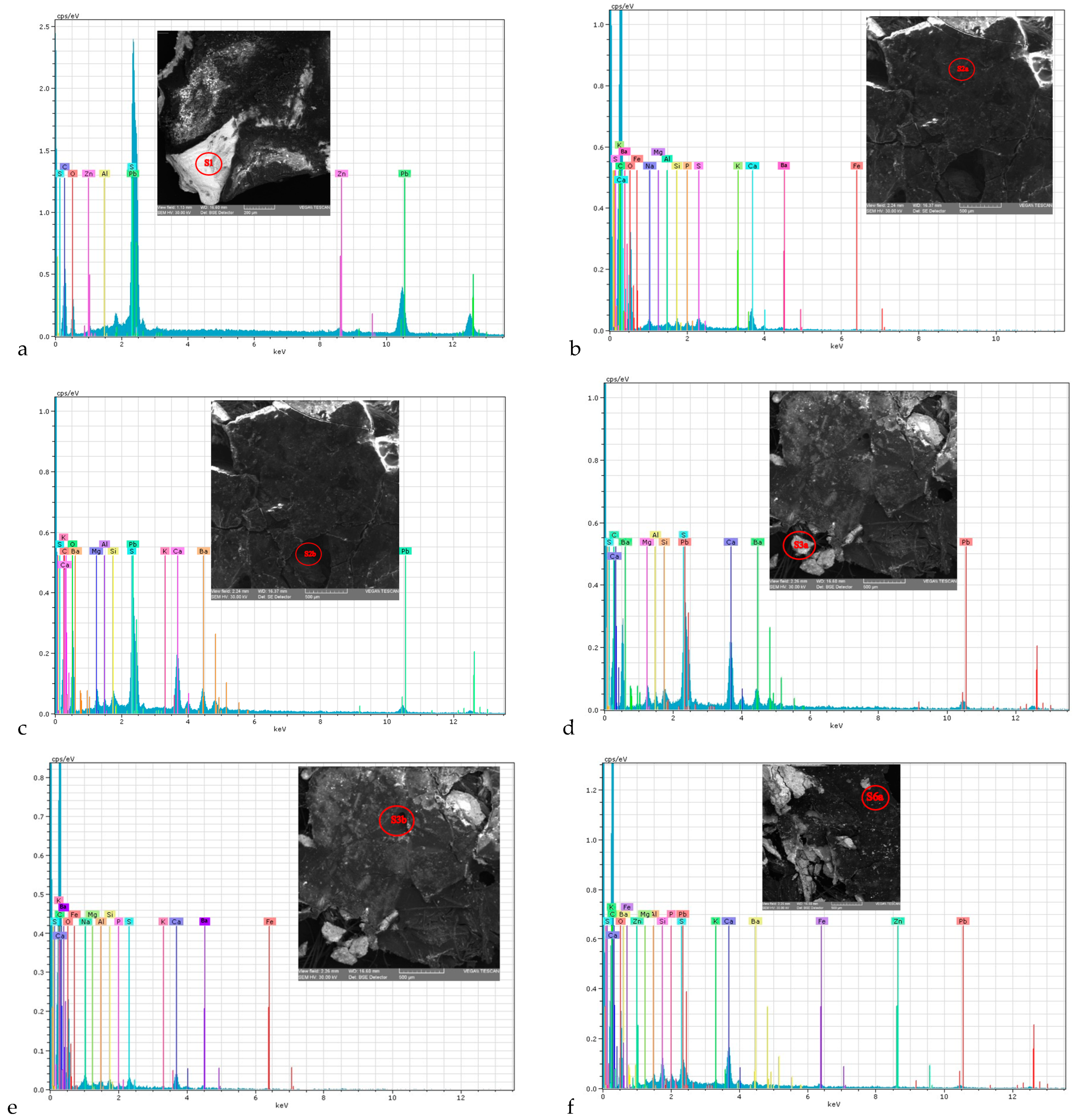

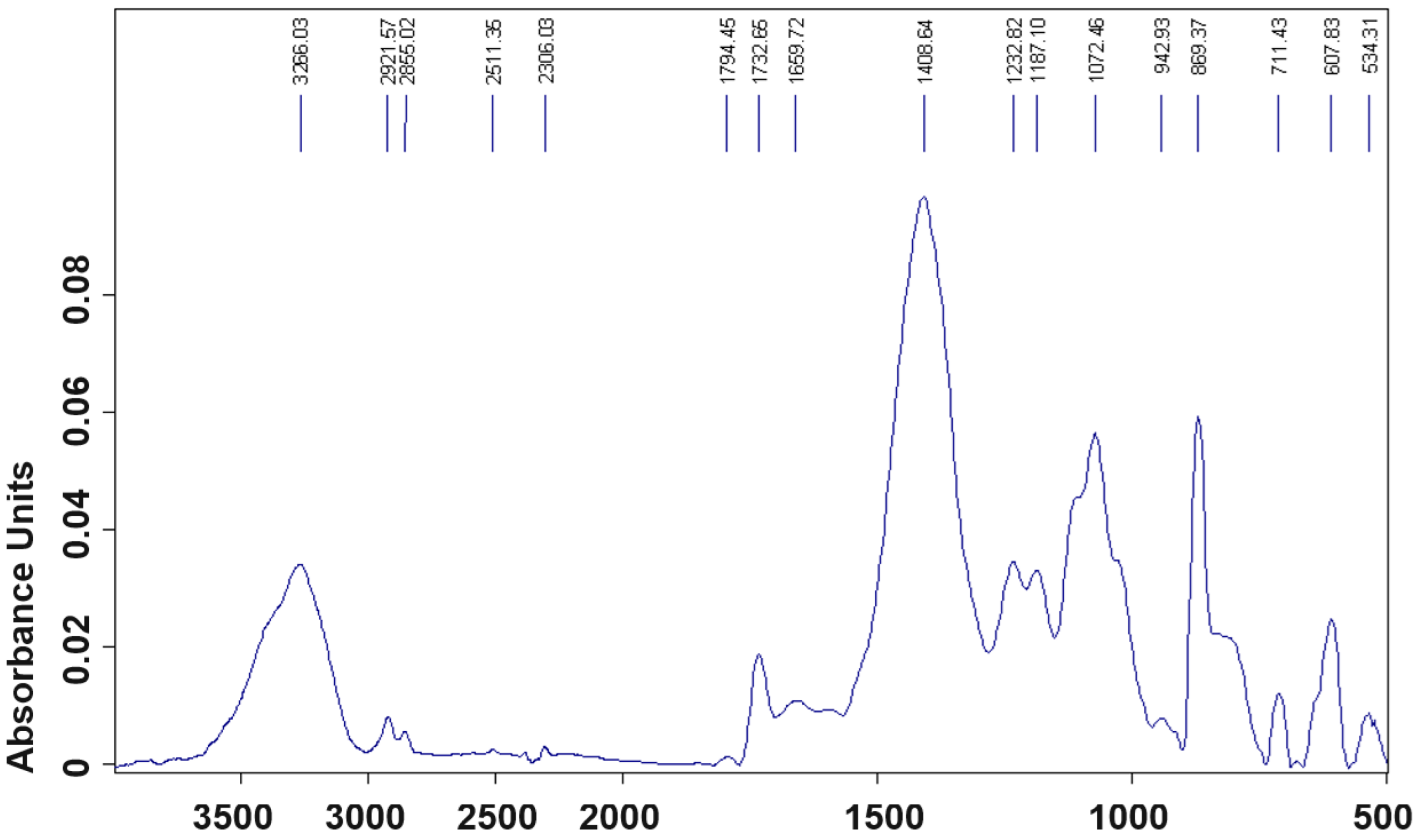
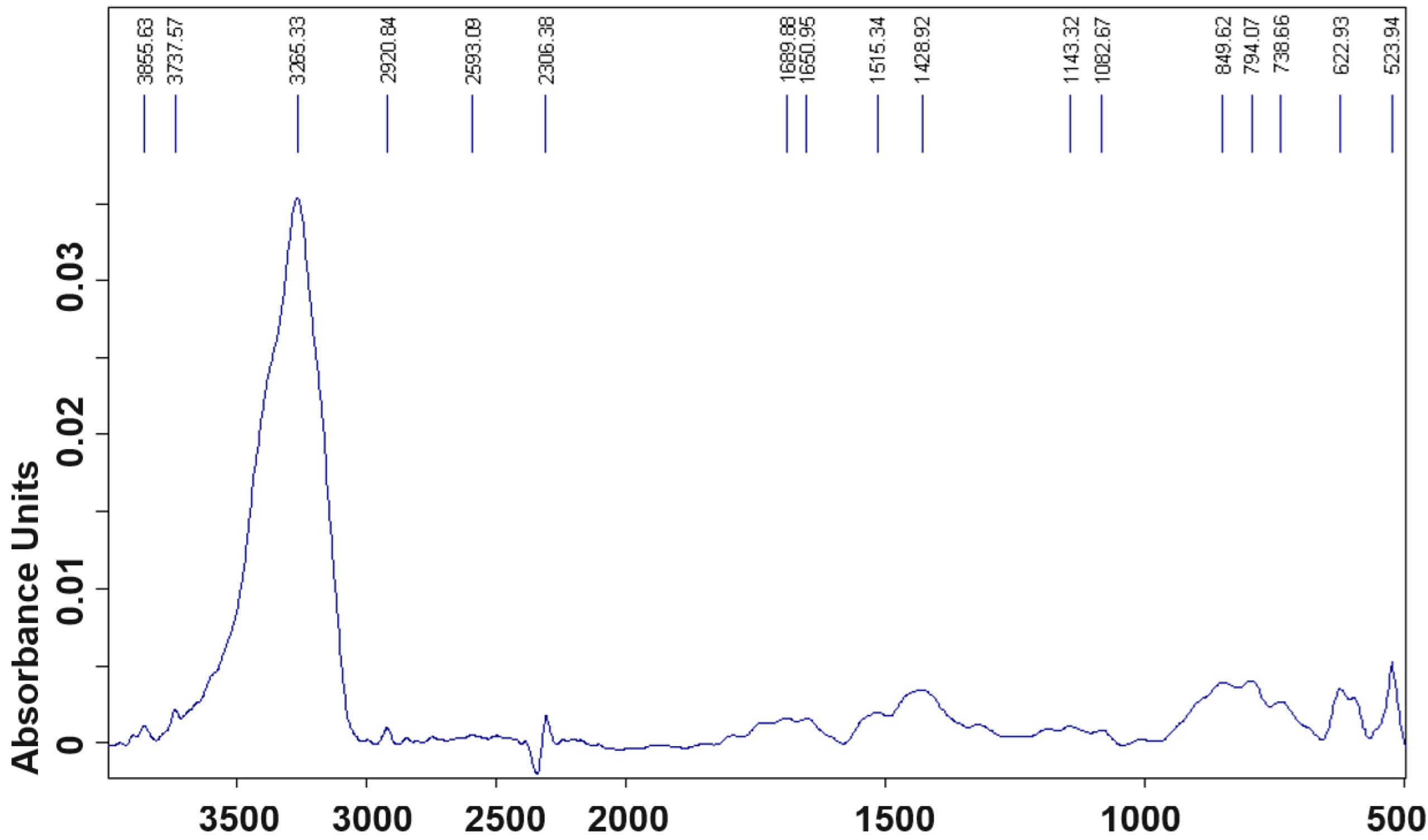

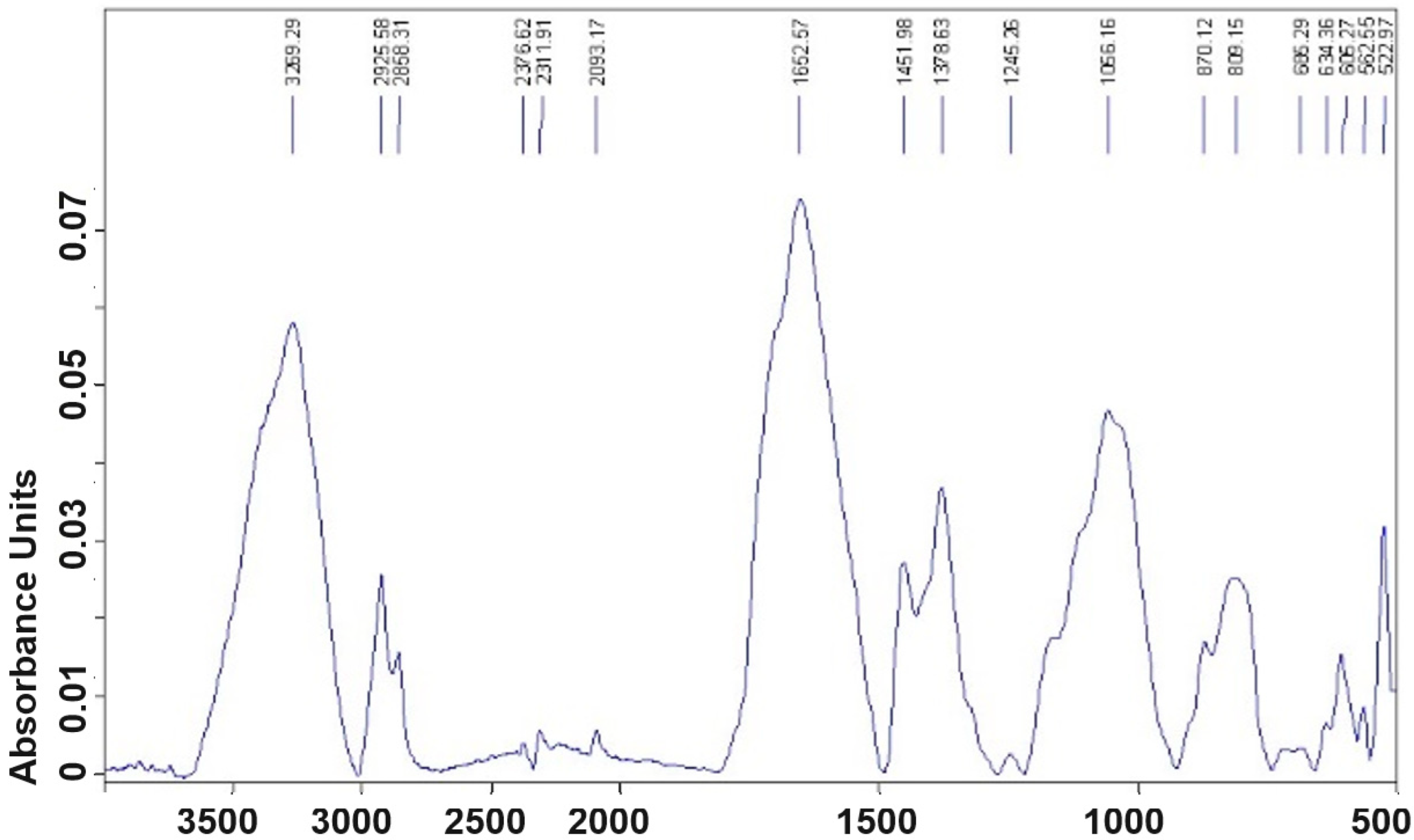
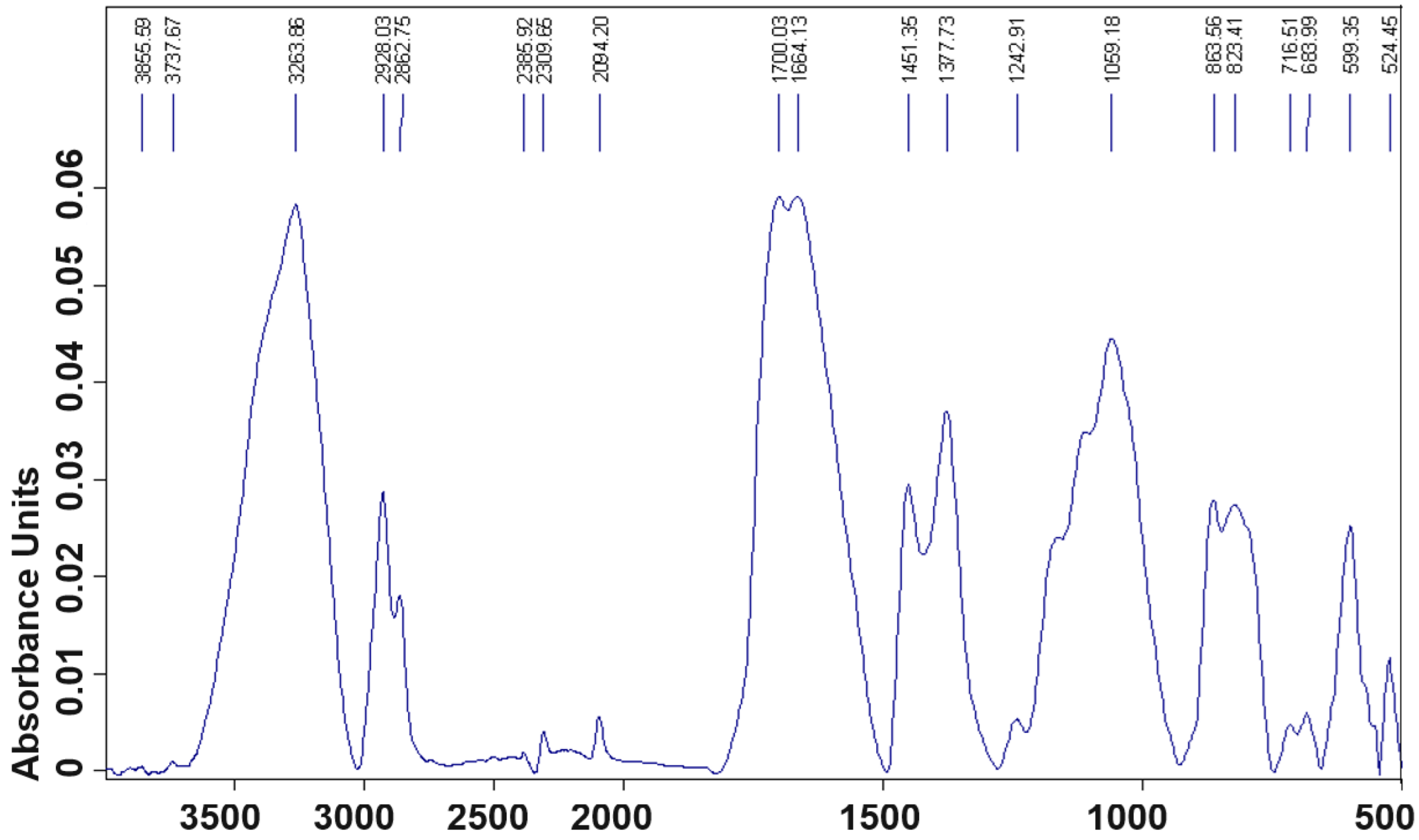
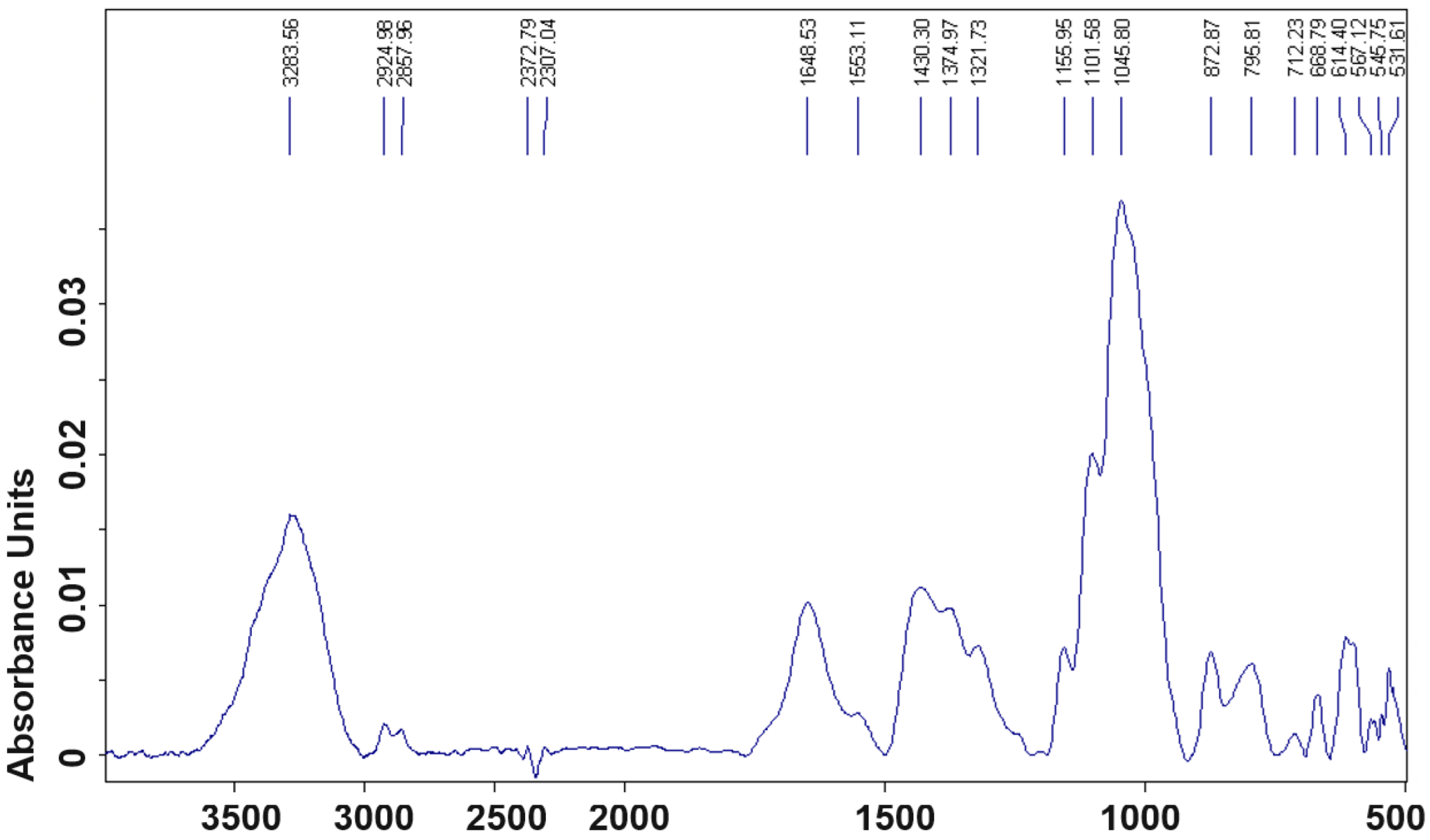
| Sample | Chemical Element | X-ray Spectra | Wt (%) | Normal Wt (%) | Normal At (%) | Error (%) |
|---|---|---|---|---|---|---|
| S1 (area with white pigment) | Lead | L-series | 37.249 | 33.065 | 3.483 | 0.968 |
| Zinc | K-series | 0.855 | 0.759 | 0.253 | 0.055 | |
| Aluminum | K-series | 0.559 | 0.497 | 0.402 | 0.063 | |
| Carbon | K-series | 17.723 | 15.732 | 28.588 | 2.594 | |
| Sulphur | K-series | 1.423 | 1.264 | 0.860 | 0.163 | |
| Oxygen | K-series | 54.845 | 48.684 | 66.414 | 8.858 | |
| Total | 112.654 | 100 | 100 | |||
| S2a (zone to stratigraphic structure) | Barium | Series—K | 1.063 | 1.249 | 0.449 | 0.082 |
| Carbon | Series—K | 15.517 | 18.231 | 26.123 | 2.326 | |
| Calcium | Series—K | 3.639 | 4.275 | 1.836 | 0.164 | |
| Sulphur | Series—K | 2.591 | 3.044 | 1.634 | 0.150 | |
| Phosphorus | Series—K | 1.687 | 1.982 | 1.101 | 0.123 | |
| Silicone | Series—K | 2.327 | 2.734 | 1.675 | 0.163 | |
| Aluminium | Series—K | 2.656 | 3.120 | 1.990 | 0.200 | |
| Sodium | Series—K | 6.790 | 7.978 | 5.972 | 0.580 | |
| Potassium | Series—K | 0.724 | 0.851 | 0.375 | 0.068 | |
| Magnesium | Series—K | 2.782 | 3.269 | 2.315 | 0.241 | |
| Iron | Series—K | 0.853 | 1.002 | 0.309 | 0.084 | |
| Oxygen | Series—K | 44.486 | 52.265 | 56.221 | 46.634 | |
| Total | 85.115 | 100 | 100 | |||
| S2b (area towards the centre of the sample) | Lead | Series—K | 7.640 | 7.640 | 0.654 | 0.269 |
| Barium | Series—K | 4.005 | 4.005 | 0.517 | 0.151 | |
| Carbon | Series—K | 14.578 | 14.578 | 21.536 | 6.108 | |
| Calcium | Series—K | 3.297 | 3.297 | 1.460 | 0.132 | |
| Sulphur | Series—K | 1.549 | 1.549 | 0.857 | 0.129 | |
| Silicon | Series—K | 0.760 | 0.760 | 0.480 | 0.069 | |
| Aluminium | Series—K | 0.557 | 0.557 | 0.366 | 0.064 | |
| Potassium | Series—K | 0.244 | 0.244 | 0.111 | 0.039 | |
| Magnesium | Series—K | 1.836 | 1.836 | 1.340 | 0.150 | |
| Oxygen | Series—K | 65.532 | 65.554 | 73.659 | 22.166 | |
| Total | 99.978 | 100 | 100 | |||
| S3a (preparation area) | Lead | Series—K | 8.269 | 8.269 | 0.688 | 0.357 |
| Zinc | Series—K | 0.676 | 0.676 | 0.178 | 0.067 | |
| Barium | Series—K | 1.638 | 1.638 | 0.206 | 0.101 | |
| Carbon | Series—K | 21.159 | 21.159 | 30.351 | 8.781 | |
| Calcium | Series—K | 1.315 | 1.315 | 0.565 | 0.084 | |
| Sulphur | Series—K | 0.997 | 0.997 | 0.536 | 0.133 | |
| Aluminium | Series—K | 1.735 | 1.735 | 1.108 | 0.138 | |
| Silicon | Series—K | 2.136 | 2.136 | 1.310 | 0.142 | |
| Sodium | Series—K | 0.709 | 0.709 | 0.531 | 0.589 | |
| Potassium | Series—K | 0.879 | 0.879 | 0.387 | 0.068 | |
| Magnesium | Series—K | 1.162 | 1.162 | 0.824 | 0.124 | |
| Iron | Series—K | 0.740 | 0.740 | 0.228 | 0.067 | |
| Oxygen | Series—K | 58.580 | 58.585 | 63.088 | 20.765 | |
| Total | 99.995 | 100 | 100 | |||
| S3b (area towards the centre of the sample) | Barium | Series—K | 1.090 | 1.090 | 0.373 | 0.105 |
| Carbon | Series—K | 20.413 | 20.414 | 27.833 | 9.066 | |
| Calcium | Series—K | 2.404 | 2.404 | 0.982 | 0.149 | |
| Sulphur | Series—K | 1.730 | 1.730 | 0.884 | 0.135 | |
| Phosphorus | Series—K | 0.718 | 0.718 | 0.379 | 0.092 | |
| Silicon | Series—K | 1.686 | 1.686 | 0.983 | 0.155 | |
| Aluminium | Series—K | 2.174 | 2.174 | 1.319 | 0.205 | |
| Sodium | Series—K | 7.782 | 7.782 | 5.544 | 0.734 | |
| Potassium | Series—K | 0.433 | 0.433 | 0.181 | 0.066 | |
| Magnesium | Series—K | 2.344 | 2.344 | 1.580 | 0.253 | |
| Iron | Series—K | 0.929 | 0.929 | 0.272 | 0.116 | |
| Oxygen | Series—K | 58.295 | 58.296 | 59.670 | 26.320 | |
| Total | 99.998 | 100 | 100 | |||
| S4 (area on the front of the sample, with pictorial material, preparation and anchored dirt) | Barium | Series—K | 3.928 | 4.328 | 0.583 | 0.179 |
| Zinc | Series—K | 1.886 | 2.078 | 0.588 | 0.137 | |
| Carbon | Series—K | 16.117 | 17.758 | 27.337 | 3.029 | |
| Calcium | Series—K | 1.930 | 2.126 | 0.981 | 0.109 | |
| Sulphur | Series—K | 2.359 | 2.599 | 1.499 | 0.139 | |
| Phosphorus | Series—K | 1.665 | 1.834 | 1.095 | 0.120 | |
| Silicon | Series—K | 4.070 | 4.484 | 2.952 | 0.242 | |
| Aluminium | Series—K | 3.867 | 4.260 | 2.920 | 0.261 | |
| Chlorine | Series—K | 2.469 | 2.720 | 1.419 | 0.137 | |
| Potassium | Series—K | 1.548 | 1.705 | 0.806 | 0.096 | |
| Sodium | Series—K | 5.521 | 6.082 | 4.892 | 4.400 | |
| Magnesium | Series—K | 2.610 | 2.876 | 2.188 | 0.228 | |
| Iron | Series—K | 1.929 | 2.125 | 0.704 | 0.113 | |
| Oxygen | Series—K | 40.865 | 45.025 | 52.036 | 5.952 | |
| Total | 90.764 | 100 | 100 | |||
| S5 (area on the reverse side of the sample, with preparation and traces of pictorial material) | Lead | Series—K | 15.432 | 13.870 | 1.272 | 0.533 |
| Barium | Series—K | 4.350 | 3.910 | 0.541 | 0.185 | |
| Carbon | Series—K | 16.007 | 14.386 | 22.752 | 2.834 | |
| Calcium | Series—K | 4.803 | 4.316 | 2.046 | 0.193 | |
| Sulphur | Series—K | 1.420 | 1.276 | 0.756 | 0.172 | |
| Aluminium | Series—K | 0.937 | 0.842 | 0.593 | 0.097 | |
| Silicon | Series—K | 0.626 | 0.563 | 0.380 | 0.071 | |
| Magnesium | Series—K | 1.562 | 1.404 | 1.097 | 0.154 | |
| Oxygen | Series—K | 66.128 | 59.433 | 70.563 | 12.233 | |
| Total | 111.265 | 100 | 100 | |||
| S6a (area on the front of the sample, with pictorial material, preparation and anchored dirt) | Lead | Series—K | 6.197 | 6.198 | 0.502 | 0.266 |
| Zinc | Series—K | 0.571 | 0.571 | 0.146 | 0.059 | |
| Bariu | Series—K | 1.573 | 1.573 | 0.192 | 0.090 | |
| Carbon | Series—K | 21.657 | 21.658 | 30.240 | 8.125 | |
| Calcium | Series—K | 2.996 | 2.996 | 1.254 | 0.128 | |
| Sulphur | Series—K | 0.633 | 0.633 | 0.331 | 0.083 | |
| Phosphorus | Series—K | 0.518 | 0.518 | 0.280 | 0.057 | |
| Silicon | Series—K | 1.565 | 1.565 | 0.935 | 0.109 | |
| Aluminium | Series—K | 0.925 | 0.925 | 0.575 | 0.087 | |
| Potassium | Series—K | 0.342 | 0.342 | 0.147 | 0.044 | |
| Magnesium | Series—K | 0.538 | 0.538 | 0.371 | 0.074 | |
| Iron | Series—K | 0.624 | 0.624 | 0.187 | 0.057 | |
| Oxygen | Series—K | 61.859 | 61.859 | 64.840 | 21.162 | |
| Total | 99.998 | 100 | 100 | |||
| S6b (area on the back of the sample, with preparation and traces of pictorial material) | Lead | Series—K | 14.593 | 13.553 | 1.277 | 0.512 |
| Bariu | Series—K | 6.526 | 6.061 | 0.861 | 0.244 | |
| Carbon | Series—K | 15.138 | 14.058 | 22.844 | 2.732 | |
| Calcium | Series—K | 5.561 | 5.164 | 2.515 | 0.214 | |
| Sulphur | Series—K | 1.681 | 1.561 | 0.950 | 0.175 | |
| Aluminium | Series—K | 0.284 | 0.264 | 0.191 | 0.056 | |
| Silicon | Series—K | 0.532 | 0.494 | 0.343 | 0.066 | |
| Magnesium | Series—K | 1.973 | 1.832 | 1.471 | 0.179 | |
| Oxygen | Series—K | 61.390 | 57.013 | 69.548 | 11.828 | |
| Total | 107.678 | 100 | 100 | |||
| S7 (textile fabric area) | Lead | Series—K | 5.806 | 5.806 | 0.457 | 0.249 |
| Barium | Series—K | 1.104 | 1.104 | 0.131 | 0.078 | |
| Carbon | Series—K | 17.723 | 17.730 | 24.078 | 7.087 | |
| Calcium | Series—K | 1.479 | 1.479 | 0.602 | 0.085 | |
| Sulphur | Series—K | 0.459 | 0.459 | 0.233 | 0.086 | |
| Phosphorus | Series—K | 0.035 | 0.035 | 0.018 | 0.031 | |
| Aluminium | Series—K | 0.178 | 0.178 | 0.108 | 0.046 | |
| Silicon | Series—K | 0.168 | 0.168 | 0.097 | 0.042 | |
| Potassium | Series—K | 0.109 | 0.109 | 0.046 | 0.036 | |
| Magnesium | Series—K | 0.354 | 0.354 | 0.238 | 0.065 | |
| Oxygen | Series—K | 72.576 | 72.578 | 73.992 | 24.475 | |
| Total | 99.991 | 100 | 100 | |||
| S8 (zone I, on the chassis with wood patina) | Carbon | Series—K | 20.732 | 20.733 | 26.757 | 7.341 |
| Calcium | Series—K | 1.094 | 1.094 | 0.423 | 0.079 | |
| Sulphur | Series—K | 0.513 | 0.513 | 0.248 | 0.061 | |
| Phosphorus | Series—K | 0.373 | 0.373 | 0.186 | 0.057 | |
| Silicon | Series—K | 0.861 | 0.861 | 0.475 | 0.087 | |
| Aluminium | Series—K | 1.295 | 1.295 | 0.744 | 0.122 | |
| Sodium | Series—K | 3.540 | 3.540 | 2.387 | 0.348 | |
| Magnesium | Series—K | 1.759 | 1.759 | 1.122 | 0.172 | |
| Oxygen | Series—K | 69.831 | 69.832 | 67.658 | 23.360 | |
| Total | 99.998 | 100 | 100 | |||
| S9 (zone II, on the wooden chassis, with traces of preparation) | Barium | Series—K | 8.697 | 7.738 | 1.161 | 0.310 |
| Zinc | Series—K | 7.741 | 6.888 | 2.171 | 0.271 | |
| Carbon | Series—K | 6.963 | 6.196 | 10.632 | 1.373 | |
| Calcium | Series—K | 17.800 | 15.838 | 8.145 | 0.576 | |
| Sulphur | Series—K | 4.821 | 4.290 | 2.757 | 0.233 | |
| Silicon | Series—K | 0.562 | 0.500 | 0.367 | 0.074 | |
| Aluminium | Series—K | 0.776 | 0.690 | 0.527 | 0.096 | |
| Sodium | Series—K | 0.166 | 0.147 | 0.132 | 0.156 | |
| Magnesium | Series—K | 0.607 | 0.540 | 0.458 | 0.099 | |
| Oxygen | Series—K | 64.255 | 57.173 | 73.650 | 11.046 | |
| Total | 112.388 | 100 | 100 |
| Type Ion | Theoretical Spectral Bands (cm−1) | Peak Present in Samples (cm)−1 | Samples Analysed |
|---|---|---|---|
| Silicate | 860–1175 | 942.93; 1072.46 | S1 |
| 1082.67; 1143.32 | S2a | ||
| 910.30; 1028.13; 1069.84 | S2b | ||
| 1059.18 | S3a | ||
| 1056.16 | S3b | ||
| 872.87; 1101.58; 1045.80; 1155.95 | S7 | ||
| Aluminate | 790–920 | 869.37 | S1 |
| 849.62 | S2a | ||
| 803.75; 869.16 | S2b | ||
| 863.56 | S3a | ||
| 809.15; 870.12 | S3b | ||
| 795.81; 872.87 | S7 | ||
| Sulphate and sulphide | 570–680; 960–1030 | 607.83 | S1 |
| 622.93 | S2a | ||
| 606.02 | S2b | ||
| 599.35 | S3a | ||
| 605.27 | S3b | ||
| 1030.12 | S7 | ||
| Carbonate | 670–745; 800–890; 1040–1100; 1320–1530; 2235–2925; 3405–3540 | 711.43, 1408.64 | S1 |
| 738,66; 1428.92; 2306 | S2a | ||
| 710.56; 1404.30 | S2b | ||
| 716,51; 1377.73; 1451.35; 2385 | S3a | ||
| 1378.63; 1451.98; | S3b | ||
| 668.79; 872.87; 2924.98; 3283.56 | S7 | ||
| Pb (II, III, IV) | 607–899; 1187–1732; 3000–3266 | 607.83: 869.37; 1072.46; 1187.10; 1408.64; 1732.66; 3266.03 | S1 |
| 599.35; 622.93; 794.07; 1069.18; 1428.92; 1451.35; 1700.03; 3263.86 | S2a and S3a | ||
| 606.02; 803.75; 1069.84; 1404.38; 1626.33; 3266.38 | S2b and S3b | ||
| 872.87; 1155.95; 1648,53; 3283.56; | S7 | ||
| Ba(II) | 603–634; 971–1063; 1108–1180 | 634,36, 981, 1063, 1108, 1180 | S2b and S3b |
| 614.40; 1101.58 | S7 | ||
| Fe(II, III) | 523; 915; 1042; 1626; 2376; 2436 | 523, 915, 1042, 1626, 2376, 2436 | S2a and S3a |
| Zn(II) | 524, 1072, 1377, 1740, 3459 | 524, 1072, 1377, 1740, 3459 | S1 (traces, weak/low peaks) |
| Acvo and hydroxocomplexes (coordination water) and crystallized water | 2850–4000 | 2855.02; 2921.57; 3266.03 | S1 |
| 2920.84; 3265.33; 3737.57; 3855.63 | S2a | ||
| 2857.57; 2922.49; 3266.38 | S2b | ||
| 2862.75; 2928.033263.86 | S3a | ||
| 2858.31; 2925.58 | S3b | ||
| 2857.96; 2924.98; 3283.56 | S7 | ||
| Binder (egg protein, via amide I and amide II) | ~1547; 1621–1690 | 1659.72 | S1 |
| 1515.34; 1650.95 | S2a | ||
| 1626.13 | S2b | ||
| 1664.13 | S3a | ||
| 1652.57 | S3b | ||
| 1553.11; 1648.53 | S7 | ||
| Varnish (through ester groups) | ~1265; ~1750 | 1232.82; 1732.66 | S1 |
| 1794.39 | S2a | ||
| 1700.03; 1242.91 | S3a | ||
| 1245.26 | S3b | ||
| Anchored dirt (carbonyl, carboxyl, ether, ethylenic and C-H groups) | 590–670; 1104; 1450–1620; 2930–3335; 3400–3512 | 605.27; 683.99; 1066.16; 1451.98; 1662.57; 2928.03; 3263.86 605.27; 685.29; 1056.16; 1451.96; 1652.57 2925.58; 3269.29 596; 667; 1104; 1458; 1619; 2934; 3237; 3335; 3398; 2512 | S2a S3a S7 |
| Sample | Chemometric Characteristics | ||||
|---|---|---|---|---|---|
| S/C * | Ca/Ba * | Pb/Ba * | Si/Al ** | Zn/Pb ** | |
| S1 (area with white pigment) | 0.080 | - | - | - | 0.023 |
| S2a (area to stratigraphic structure) | 0.167 | 3.423 | - | 0.876 | - |
| S2b (area towards the centre of the sample) | 0.106 | 0.823 | 1.908 | 1.365 | - |
| S3a (preparation area) | 0.047 | 0.803 | 5.048 | 1.231 | 0.082 |
| S3b (area towards the centre of the sample) | 0.085 | 2.206 | - | 0.776 | - |
| S4 (area on the front of the sample, with pictorial material, preparation and anchored dirt) | 0.146 | 0.491 | - | 1.053 | - |
| S5 (area on the back of the sample, with preparation and traces of pictorial material) | 0.089 | 1.104 | 3.547 | 0.669 | - |
| S6a (area on the front of the sample, with pictorial material, preparation and anchored dirt) | 0.029 | 1.905 | 3.940 | 1.692 | 0.092 |
| S6b (area on the back of the sample, with preparation and traces of pictorial material) | 0.111 | 0.852 | 2.236 | 1.871 | - |
| S7 (textile fabric area) | 0.026 | 1.340 | 5.259 | 0.944 | - |
| S8 (zone I, on the chassis with patinated wood) | 0.025 | - | - | 0.665 | - |
| S9 (zone II, on the wooden chassis, with traces of preparation) | 0.692 | 2.047 | - | 0.725 | - |
Disclaimer/Publisher’s Note: The statements, opinions and data contained in all publications are solely those of the individual author(s) and contributor(s) and not of MDPI and/or the editor(s). MDPI and/or the editor(s) disclaim responsibility for any injury to people or property resulting from any ideas, methods, instructions or products referred to in the content. |
© 2024 by the authors. Licensee MDPI, Basel, Switzerland. This article is an open access article distributed under the terms and conditions of the Creative Commons Attribution (CC BY) license (https://creativecommons.org/licenses/by/4.0/).
Share and Cite
Sandu, I.; Drobota, V.; Drob, A.; Sandu, A.V.; Vasilache, V.; Iurcovschi, C.T.; Sandu, I.G. Authentication of a Painting Attributed to the Rembrandt School. Appl. Sci. 2024, 14, 8655. https://doi.org/10.3390/app14198655
Sandu I, Drobota V, Drob A, Sandu AV, Vasilache V, Iurcovschi CT, Sandu IG. Authentication of a Painting Attributed to the Rembrandt School. Applied Sciences. 2024; 14(19):8655. https://doi.org/10.3390/app14198655
Chicago/Turabian StyleSandu, Ion, Vasile Drobota, Ana Drob, Andrei Victor Sandu, Viorica Vasilache, Cosmin Tudor Iurcovschi, and Ioan Gabriel Sandu. 2024. "Authentication of a Painting Attributed to the Rembrandt School" Applied Sciences 14, no. 19: 8655. https://doi.org/10.3390/app14198655
APA StyleSandu, I., Drobota, V., Drob, A., Sandu, A. V., Vasilache, V., Iurcovschi, C. T., & Sandu, I. G. (2024). Authentication of a Painting Attributed to the Rembrandt School. Applied Sciences, 14(19), 8655. https://doi.org/10.3390/app14198655








